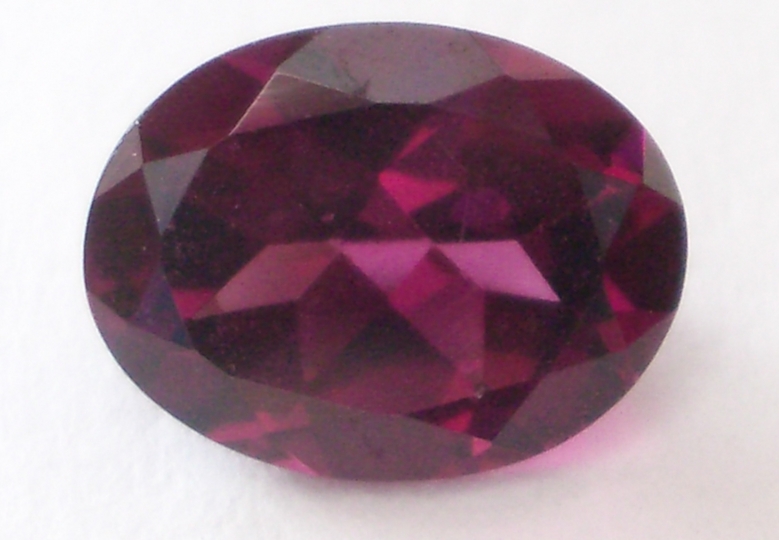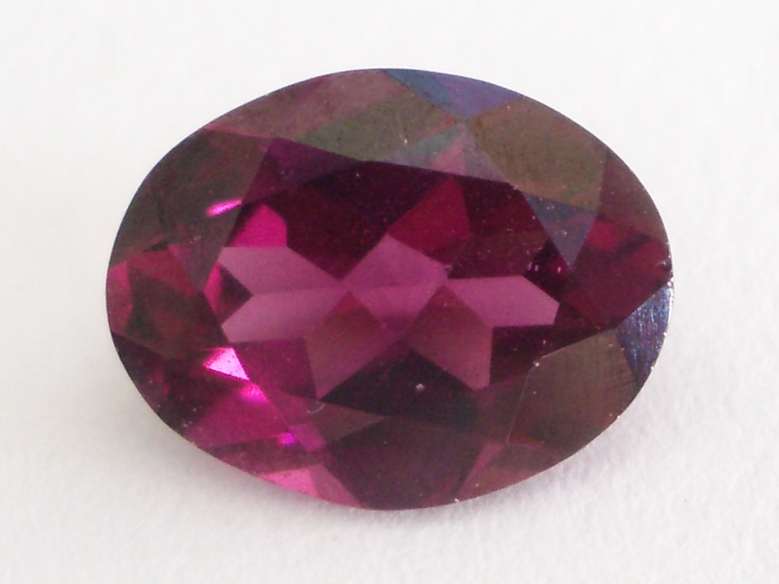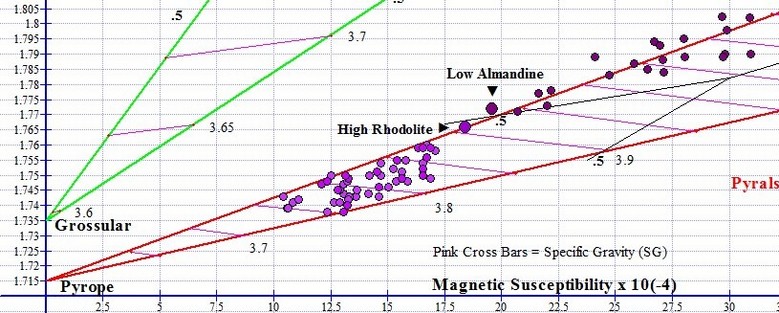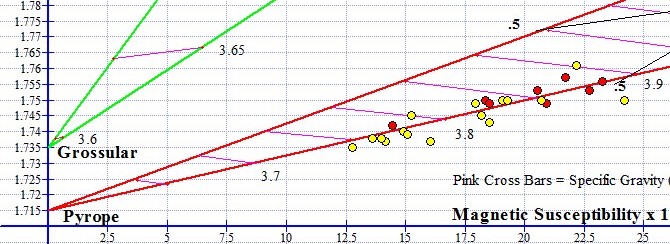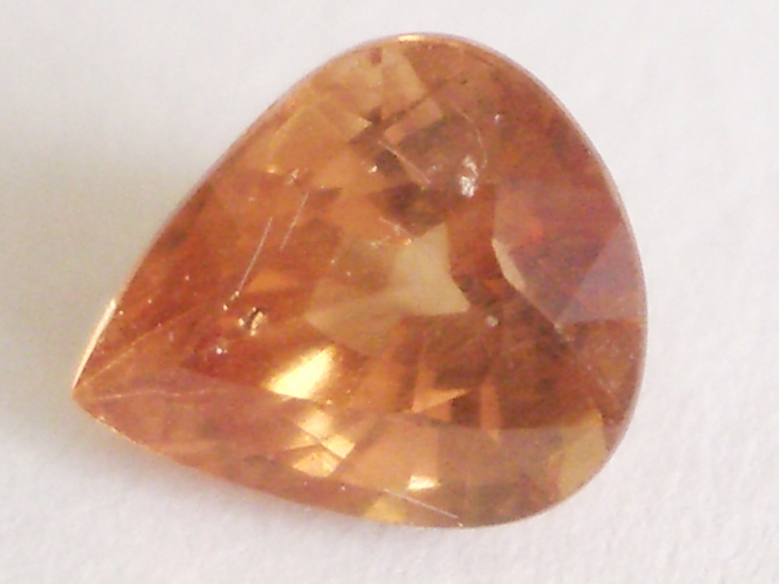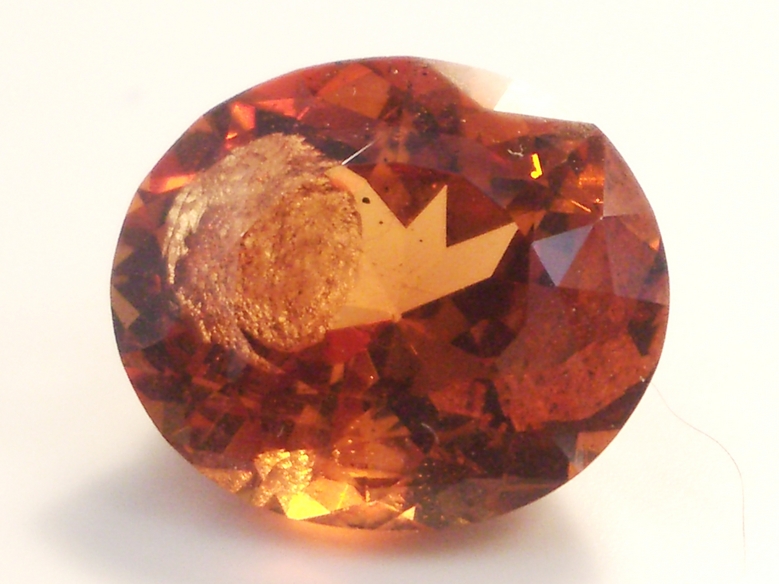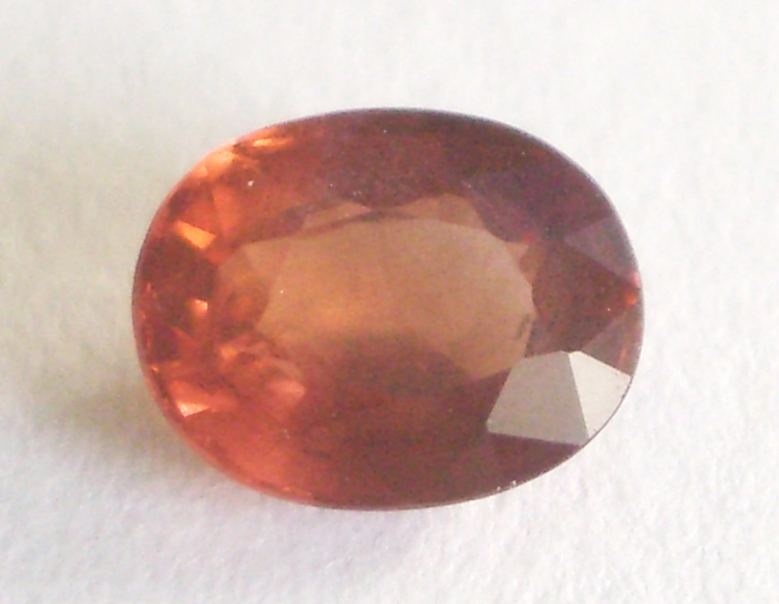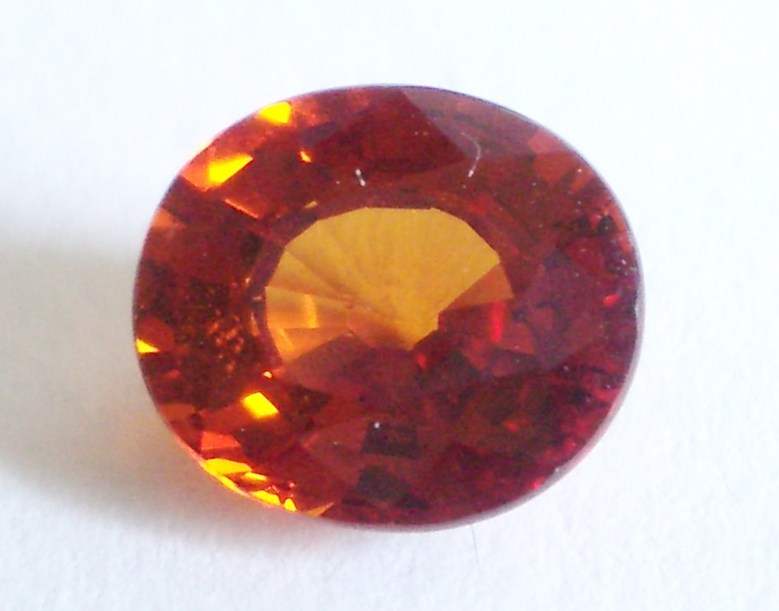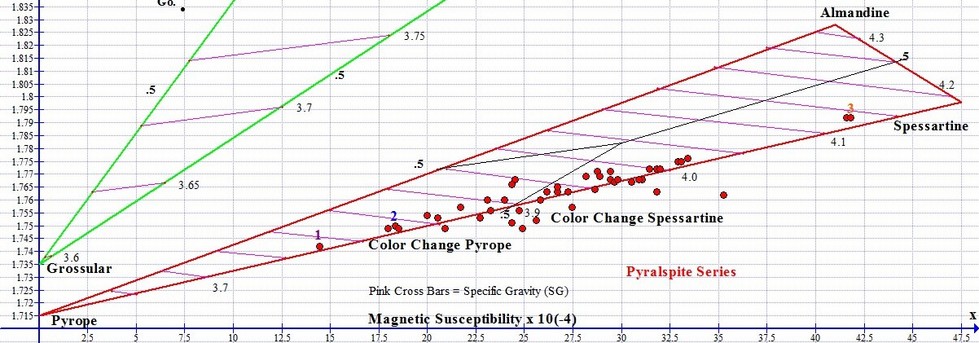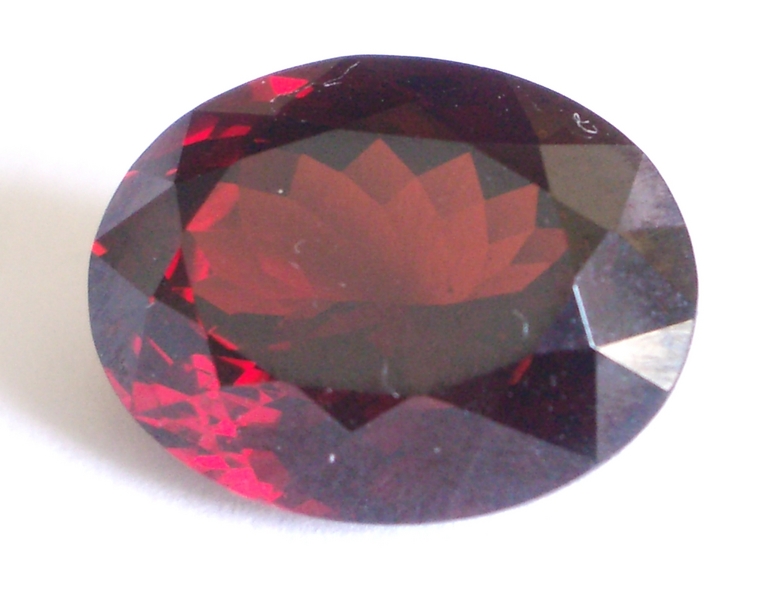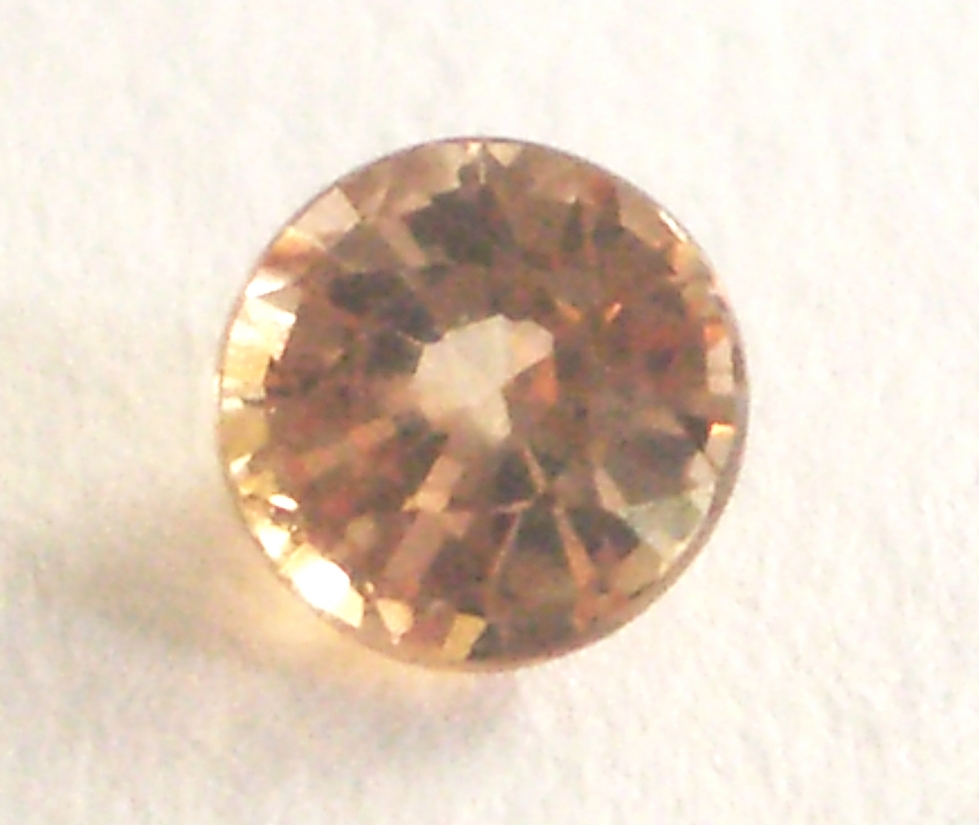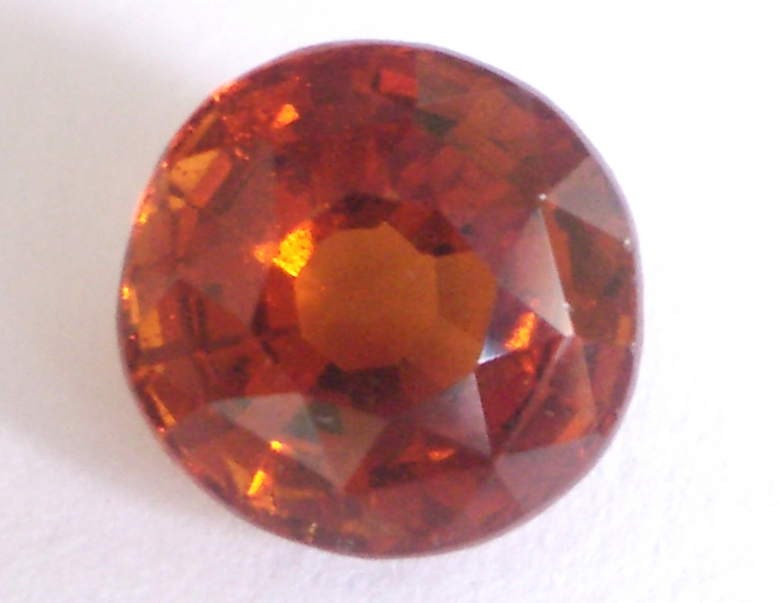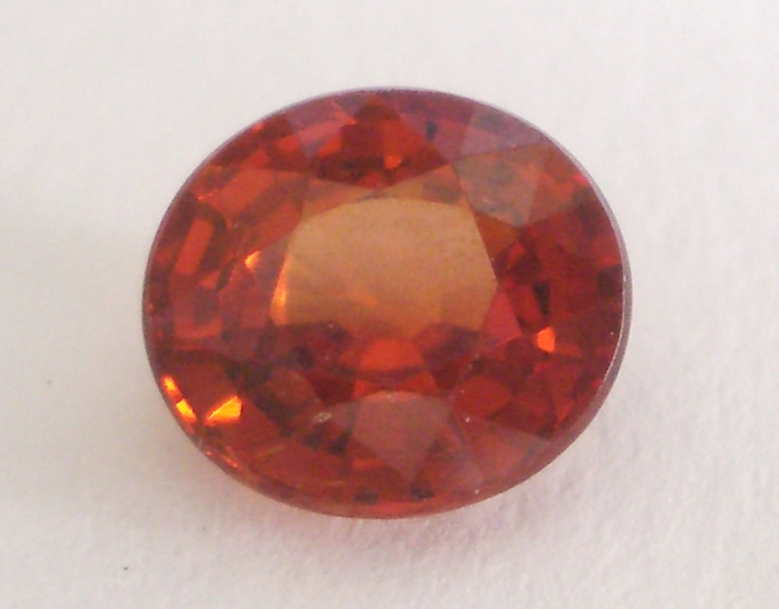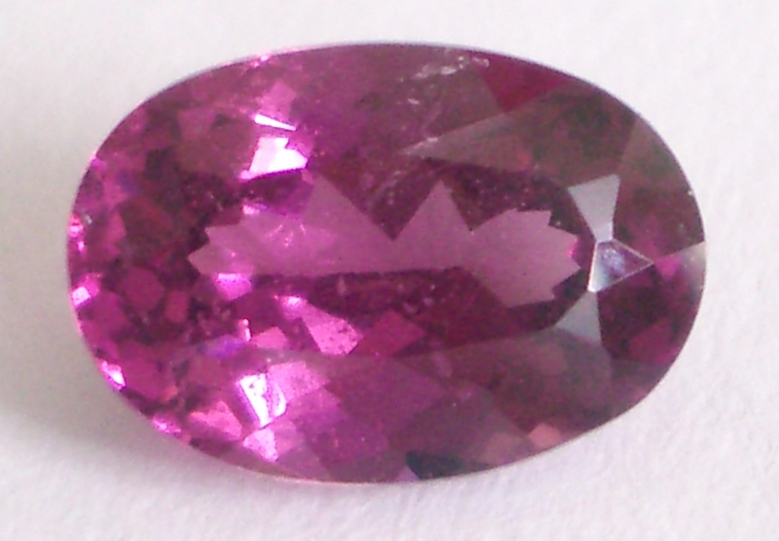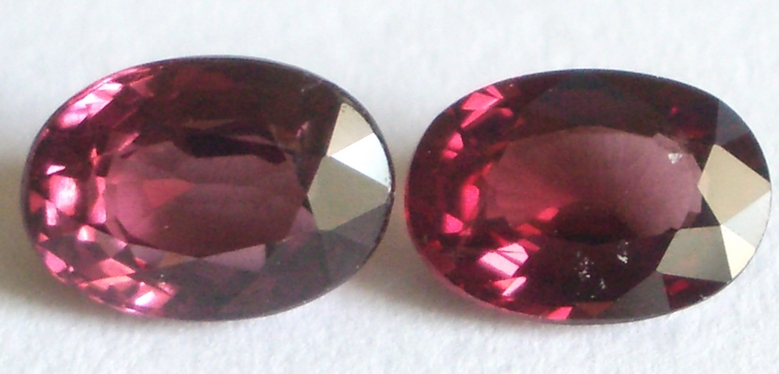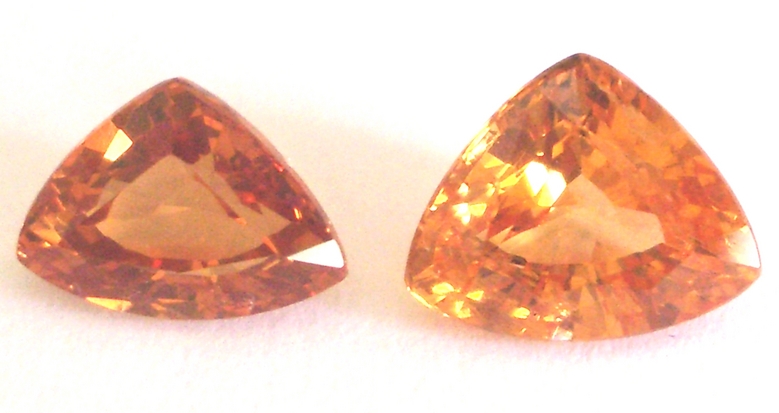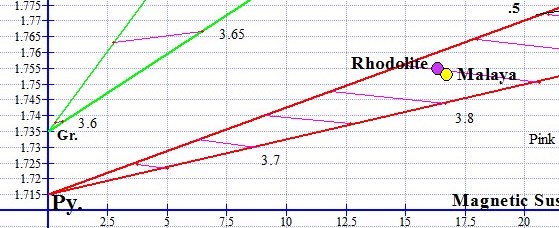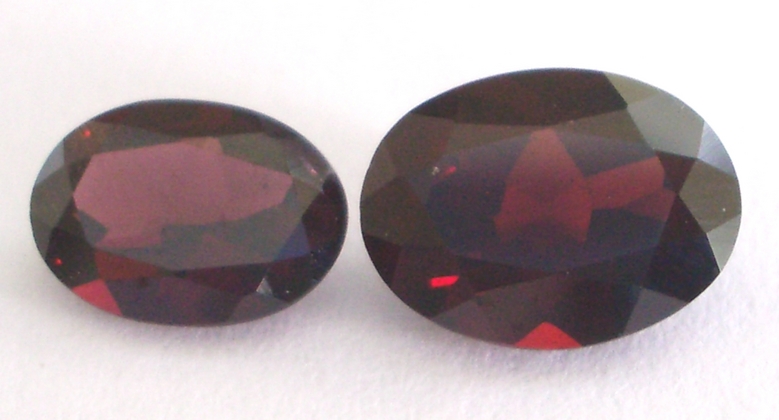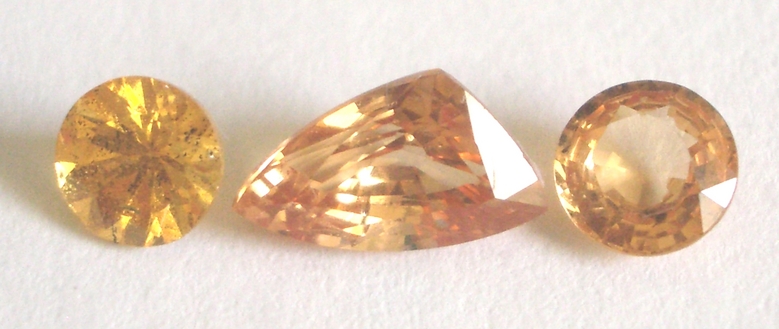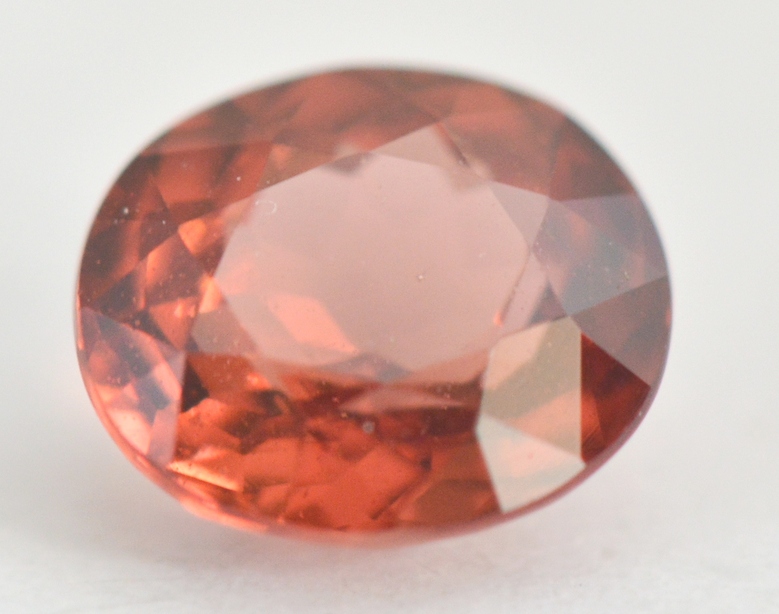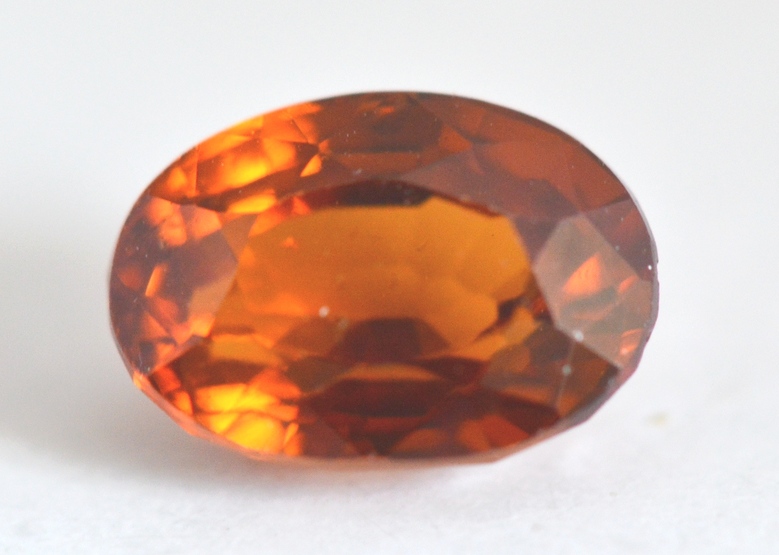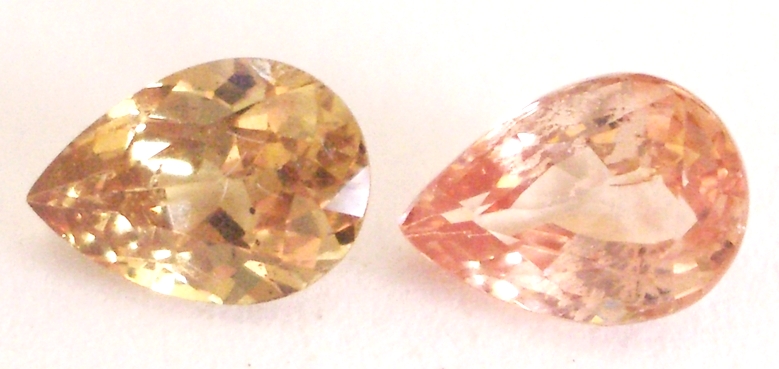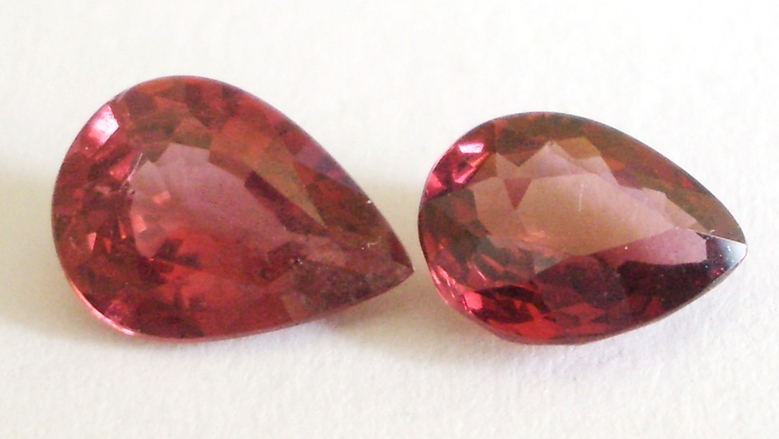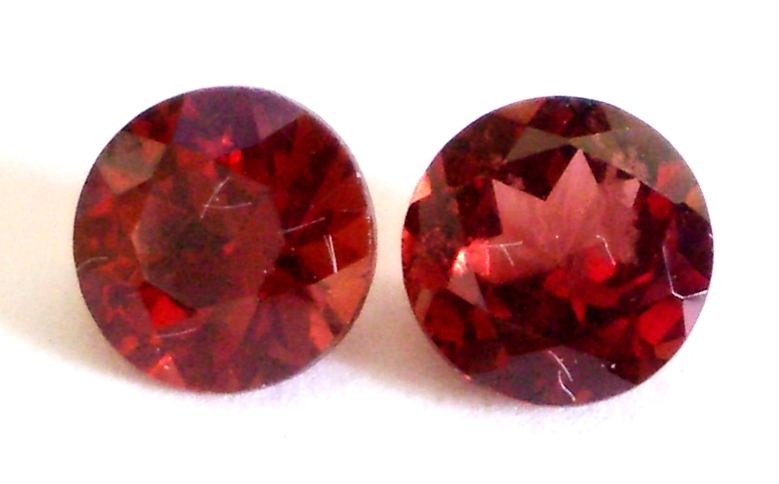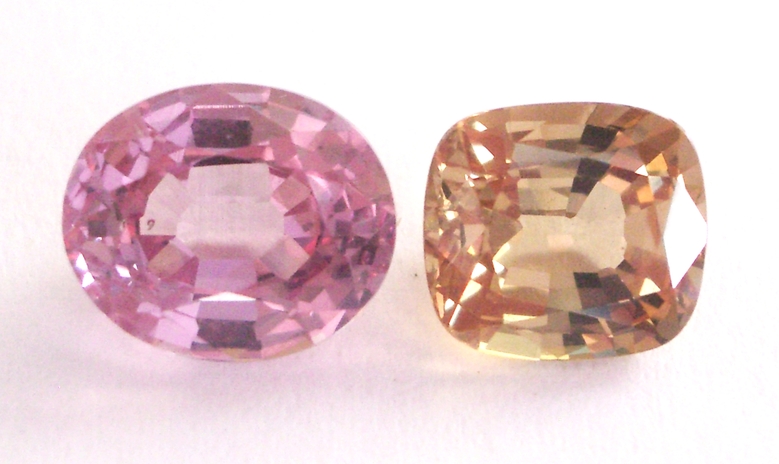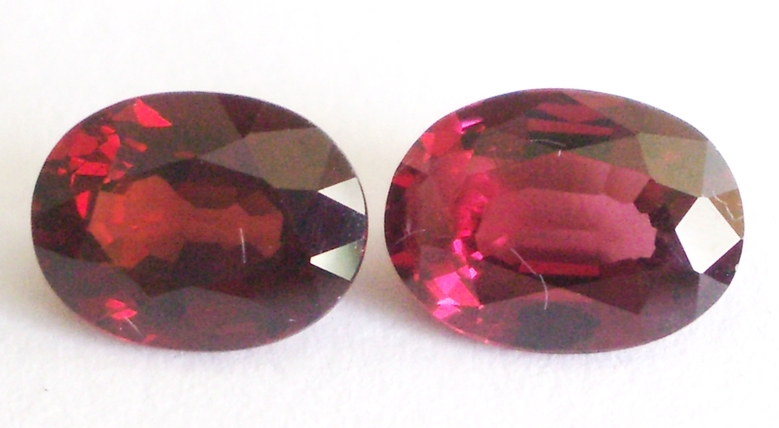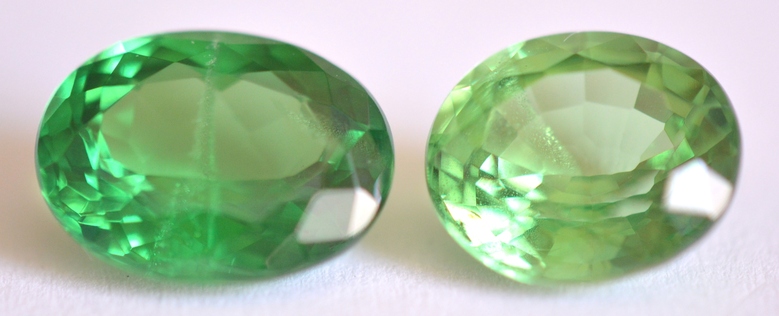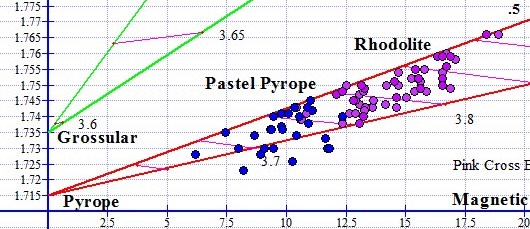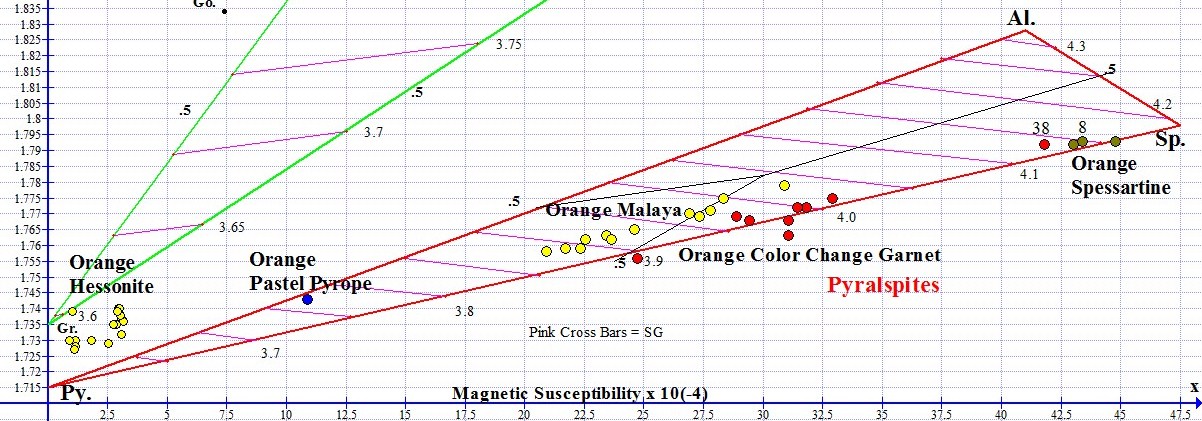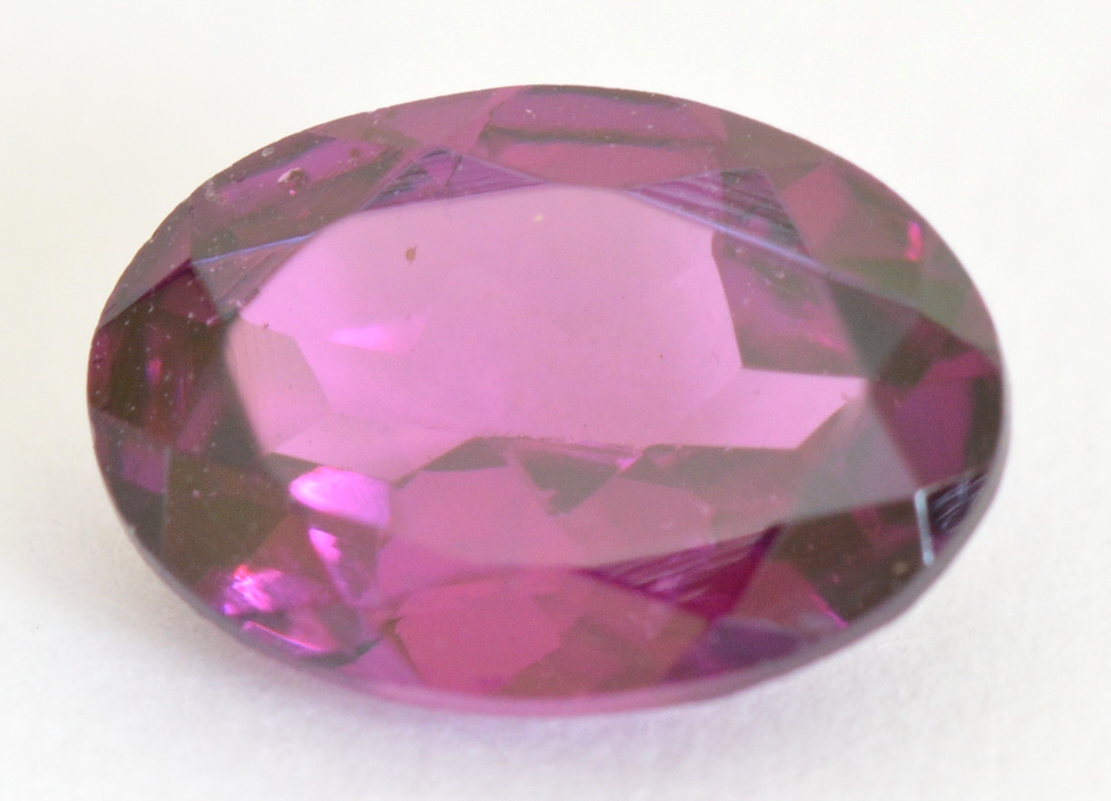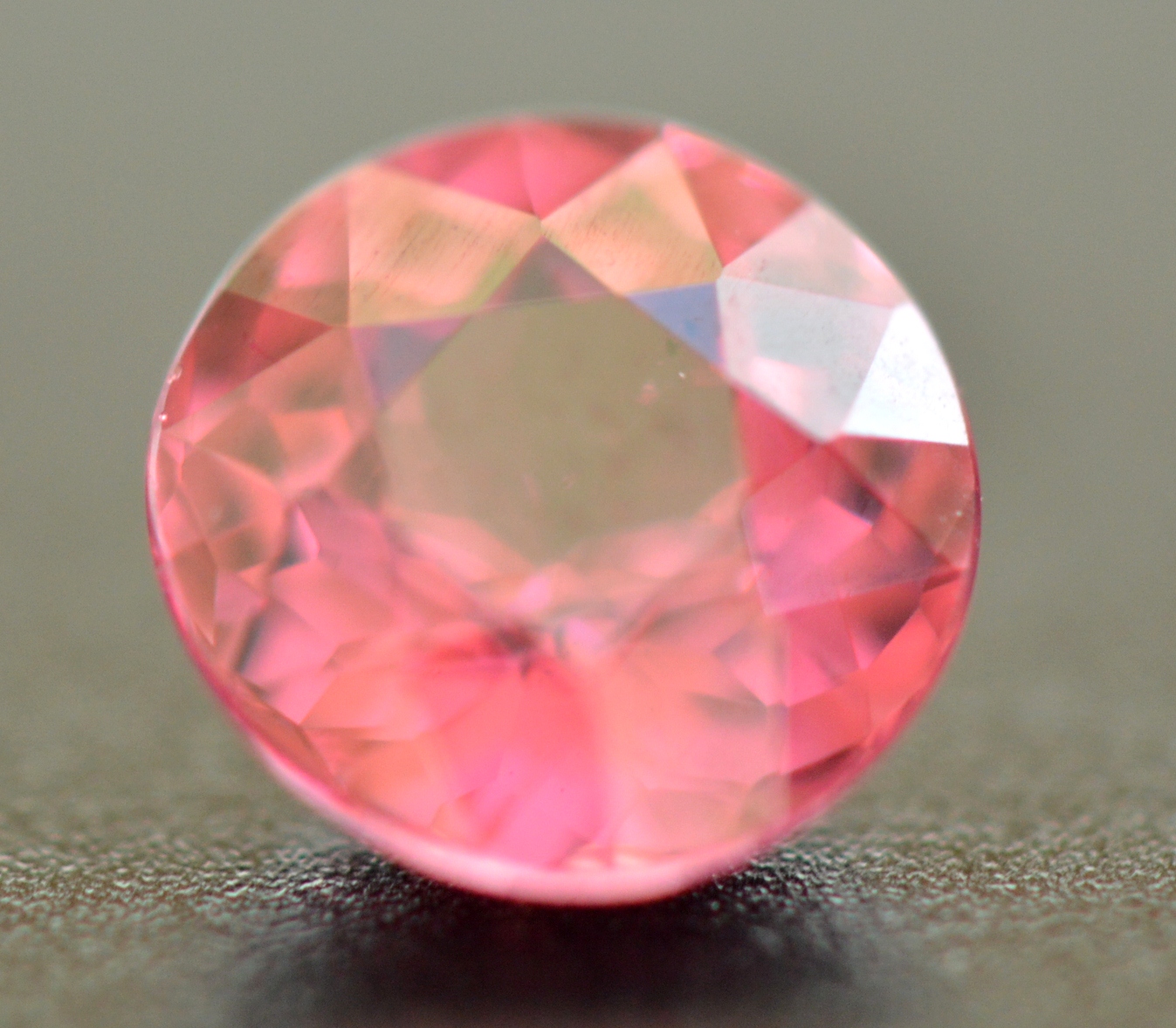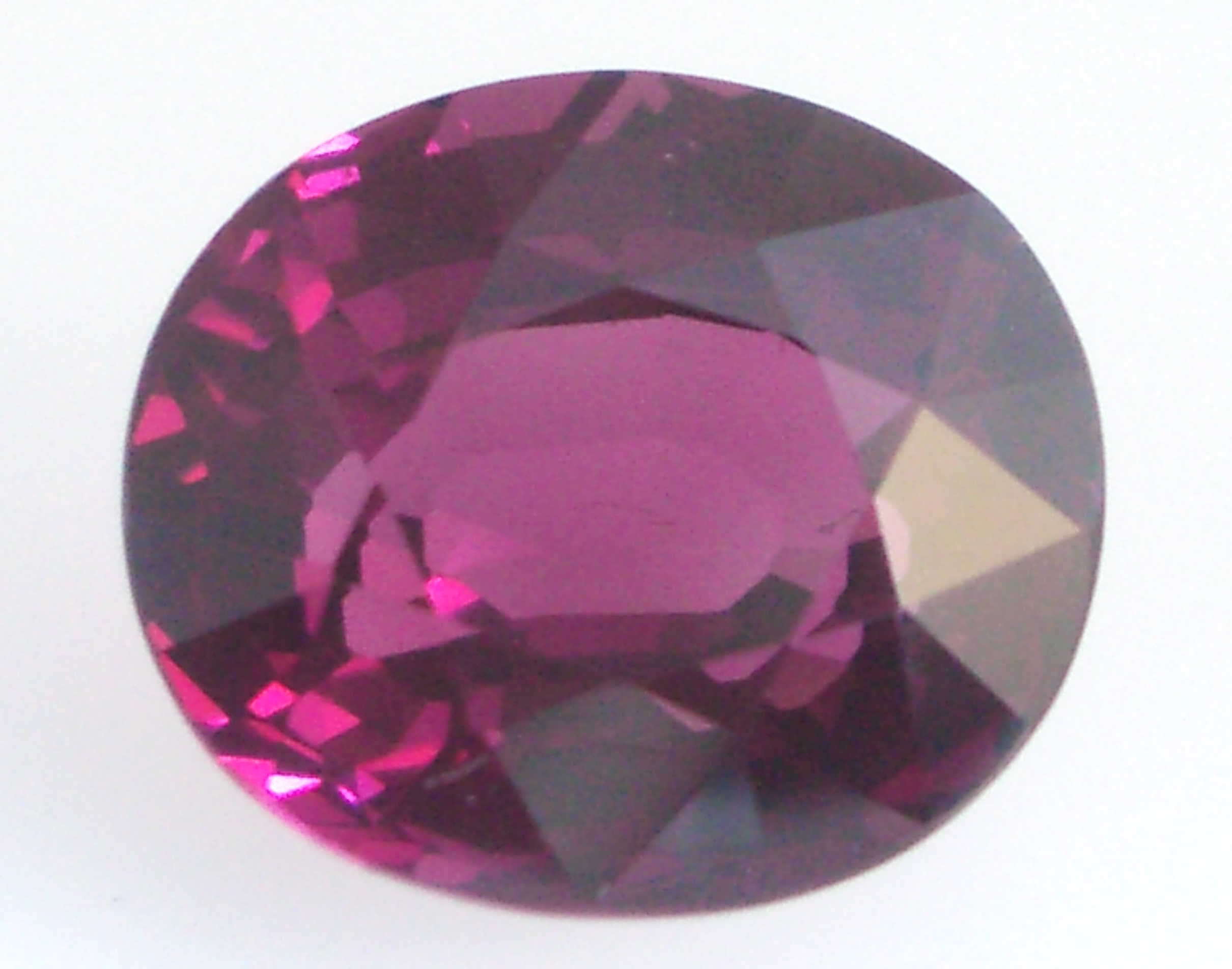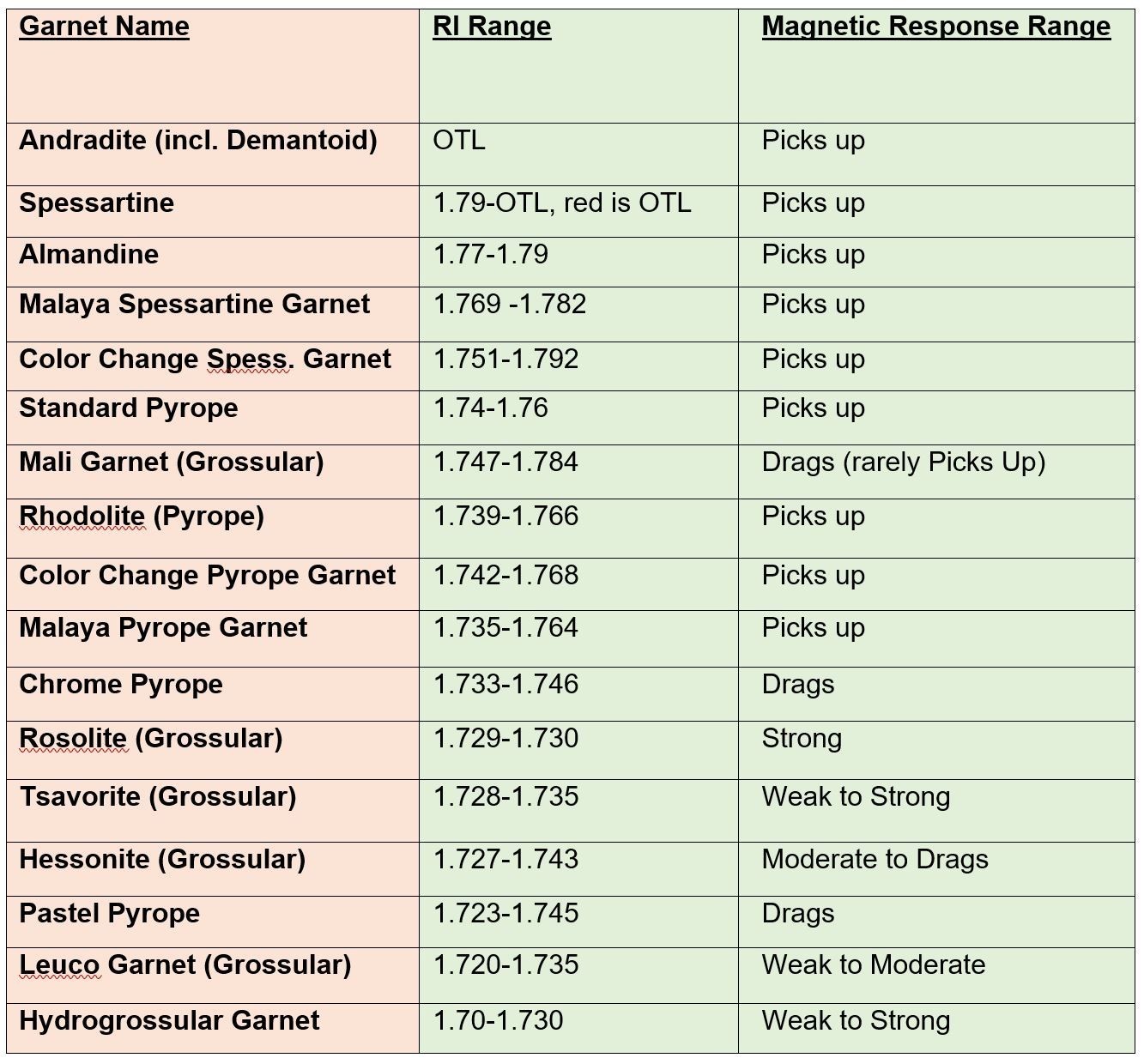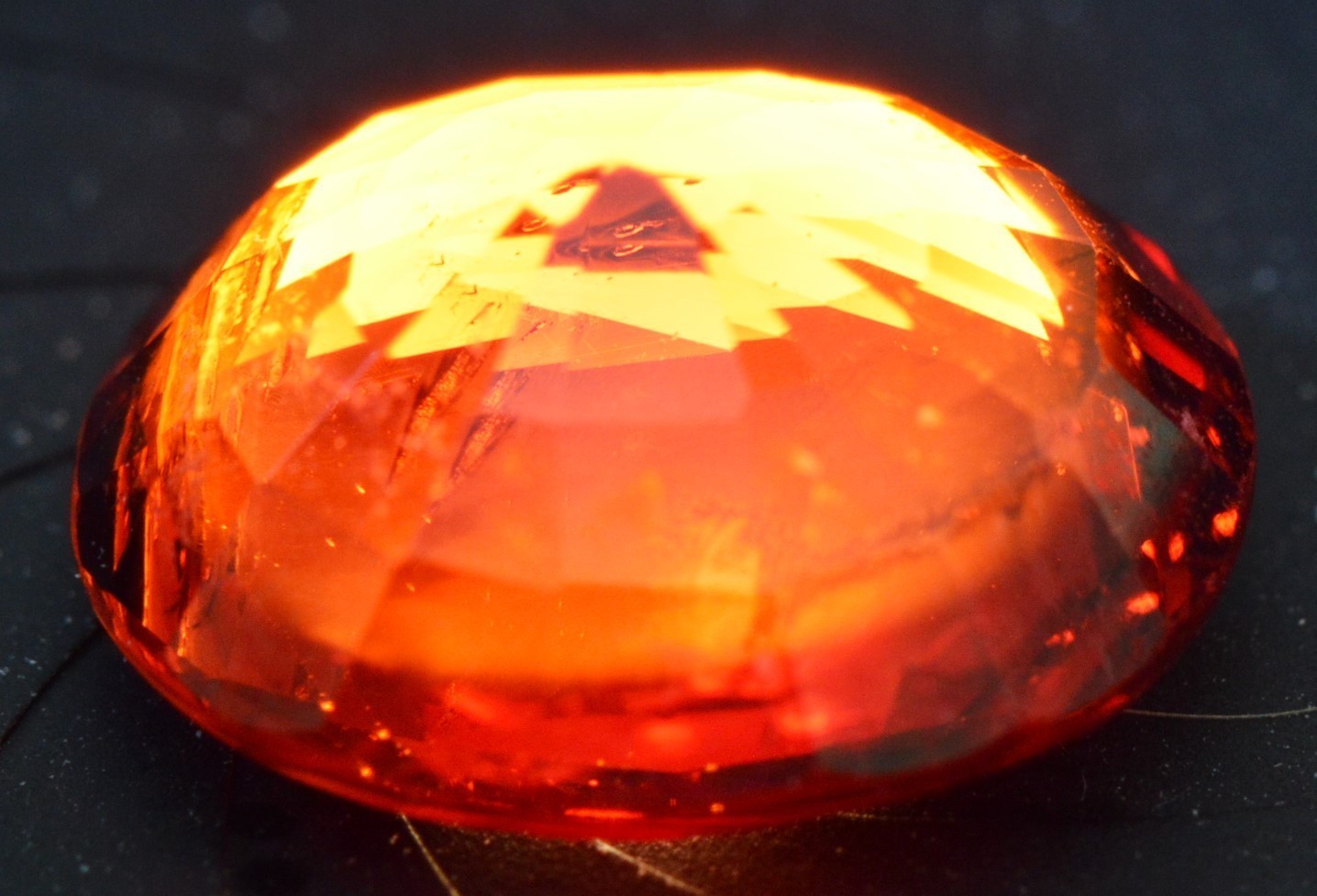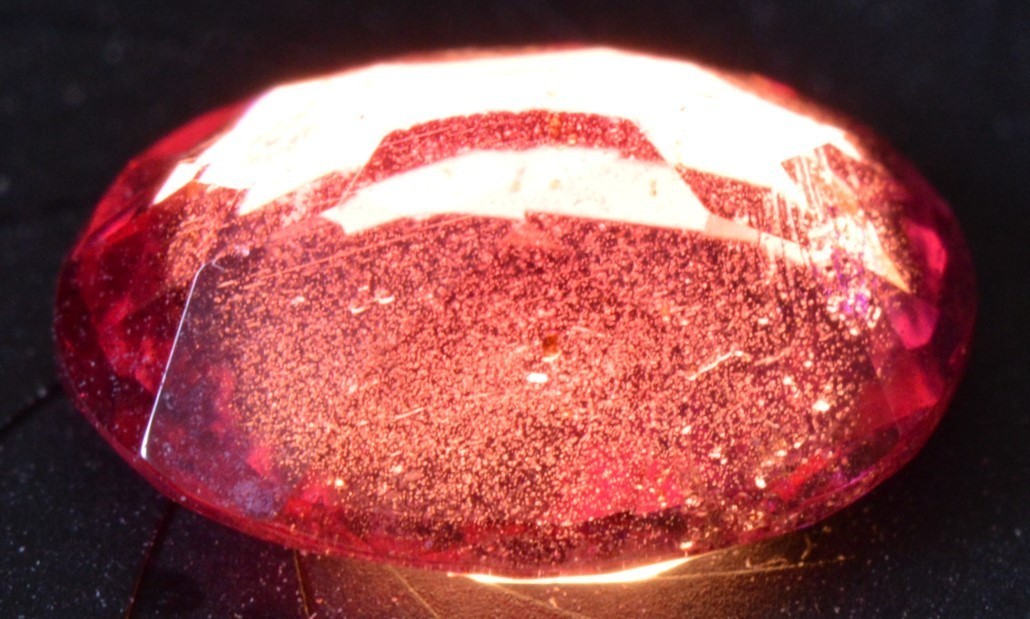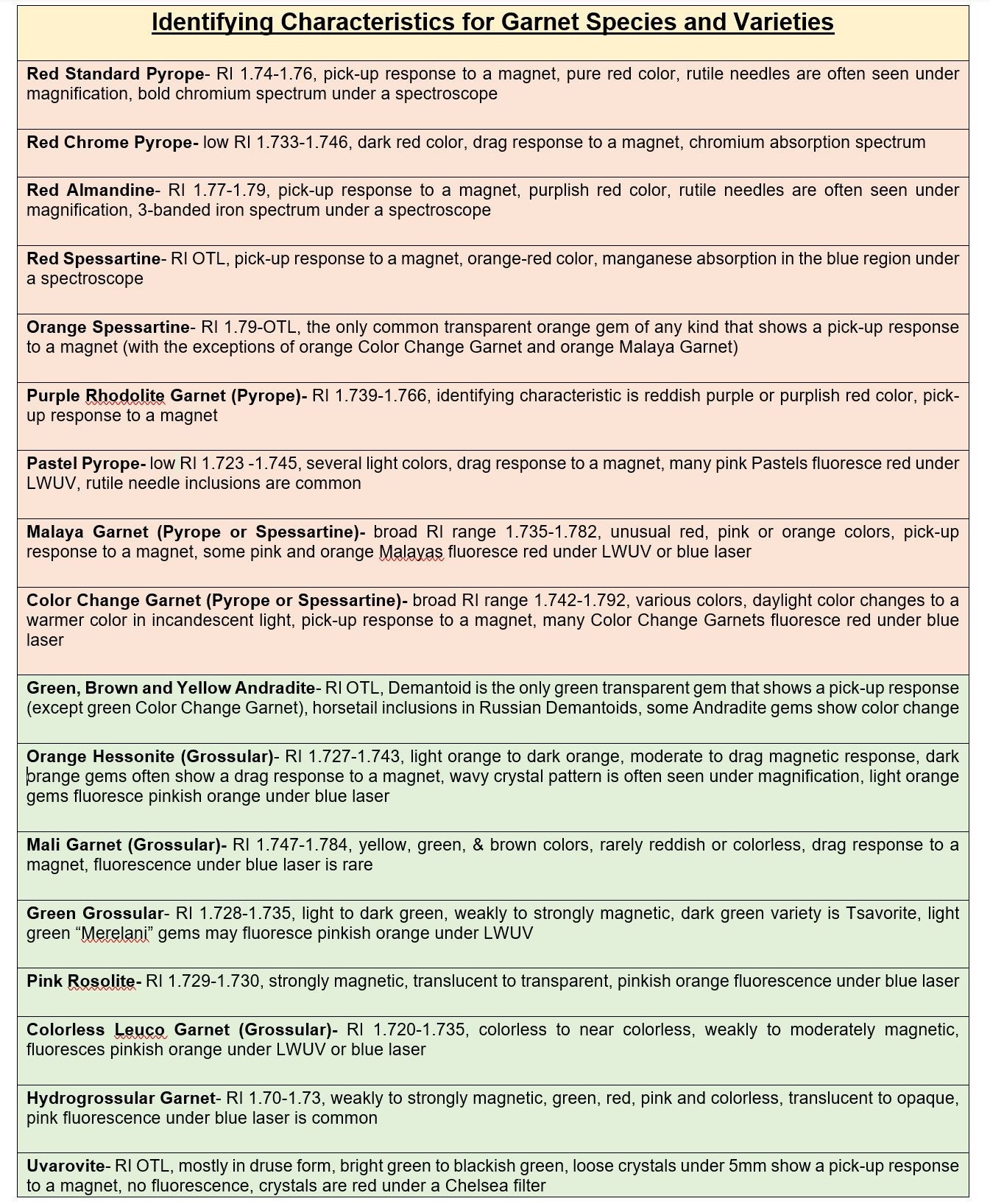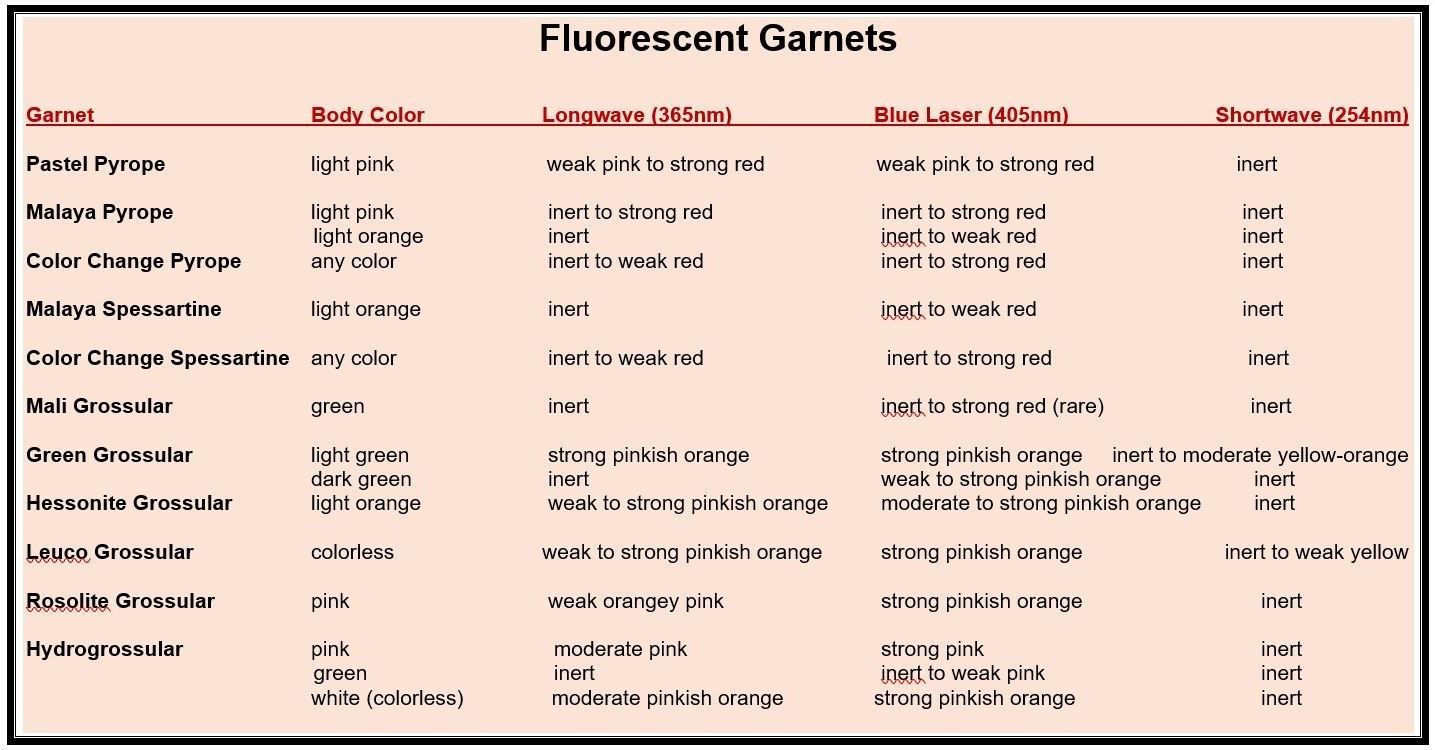© Kirk Feral 2012, All Rights Reserved. These materials may be duplicated for educational purposes only. No part of this website may be duplicated or distributed for profit, for commercial purposes, or for posting to another website, without the expressed written consent of the copyright holder.
Tsavorite & Merelani Garnets
Distinguishing Between Garnet Species and Varieties
This page provides detailed examples of how most varieties and species of Garnet can be distinguished from one another using standard testing instruments such as a magnetic wand, refractometer and spectroscope. Identification charts are included.
Ugrandite Garnet gems are easily distinguished from one another. The 3 species and multiple varieties generally do not simultaneously overlap in color, refractive index and magnetic susceptibility. For example, Green Grossular has a different color than orange Hessonite; Hessonite doesn’t share the same colors or brilliance with Mali Garnet; and Mali Garnet doesn’t have the high refractive index and magnetic susceptibility of Demantoid or brown Andradite. Perhaps the most difficult distinction we might have to make among Ugrandites is between the color variations of the Green Grossular variety: i.e. should we refer to a gem as Tsavorite with moderate green color, or Merelani with light green color?
Rhodolite: Although Rhodolite is known for its purple color, distinguishing it from other Pyropes with purple color (purple Pastels, purple Malayas and purple Color Change Garnets) can be problematic. The primary composition range of the Rhodolite variety overlaps the composition ranges of four other Pyrope varieties: Standard Pyrope, Malaya Garnet, Pastel Pyrope and Color Change Pyrope. Without a comprehensive chemical analysis to reveal the minor composition of individual gems, we must at times rely on visual appearance (hue, tone, color change or color shift) to distinguish gems of some Pyrope varieties from Rhodolite.
For example, some Rhodolites can occasionally fall within the composition range of Pastel Pyropes, with refractive indices under 1.745 and susceptibilities under 12.5 SI. In these rare instances, we distinguish the Rhodolite gems by their reddish purple color. Purple Pastels are similar in appearance, but they tend to show a purer purple (pinkish purple rather than reddish purple) in daylight.
Red Malaya & Standard Pyrope: Similar to the example above, some red Malaya Garnets and Standard Pyrope Garnets have overlapping refractive indices and magnetic susceptibilities. The major compositions can be the same for these gems. That means there may be no difference in the proportions of Pyrope, Almandine and Spessartine that make up Standard Pyropes and some red Malayas. In these cases, the lighter tones and off-red shades of red Malayas are the only parameters we have to distinguish this variety from Standard Pyrope, which tends toward darker tones and purer red colors (as shown below).
High Rhodolite
from Brazil (2.63ct)
Low Almandine
from Tanzania (1.47ct)
Chrome Pyrope & Standard Pyrope / Pastel Pyrope & Malaya Garnet: When it comes to Pyrope Garnet, visual appearance alone is often not sufficient to distinguish between the six different varieties within the Pyrope species. Sometimes gems of two different varieties can appear identical under normal lighting, as is the case with some Chrome Pyropes and Standard Pyropes when viewed in reflected light. The same is true of some Pastel Pyropes and Malaya Garnets, as is noted in the section on Pastels on page 9 of the Garnets section.
Color Change Pyrope (lft) &
Color Change Spessartine (rt)
Color Change Pyrope (lft) &
Color Change Spessartine (rt)
Identical Examples of
Chrome Pyrope & Standard Pyrope
Identical Examples of
Pastel Pyrope & Malaya
The Magnetic Susceptibility Boundary that Separates
Chrome Pyrope from Standard Pyrope is SI 10
Purple Pastel Pyrope
Pastel Pyrope and Rhodolite Compositions Can Overlap
Standard Pyrope & Red Malaya
Standard Pyrope and Malaya Compositions Can Overlap
Graph Showing a High Rhodolite & a Low Almandine
Separated by the 50% Boundary Line
Color Change Pyrope and Color Change Spessartine
are Separated by the .5 Species Boundary Line at SI 24.5.
Pink Malaya & Color Change Pyrope: There is also no difference in major composition between pink Malayas and Color Change Pyropes. Both are varieties of Pyrope that occupy the same composition range on the Pyralspite ternary. Distinctions between these gems are based solely on differences in color and color phenomena, which can be due to very small variations in trace chemistry (chromium, vanadium and titanium) and/or inter-valence charge transfer processes that are not detectable with a magnetic wand or measurable with a magnetic susceptibility balance. We refer to trace chemistry as metal oxides that make up less than 0.1% by weight of a gem's total chemistry.
Pink Malayas (yellow points) and Color Change Pyropes (red points)
Share the Same Range of Composition
Below is a pink Malaya Garnet and a yellow Color Change Garnet, both of the Pyrope species. Pink Malayas exhibit color shift from pink in daylight to reddish pink in incandescent light. Color Change Pyropes exhibit color change from a non-red colors to pink/red. Pink Malayas can show color change from pink in daylight to yellow in fluorescent light, but incandescent light is the standard light source we use to determine color change in gems.
Pink Malaya (2.19ct)
& Yellow Color Change Pyrope (1.75ct)
This concludes our discussion of natural Garnet species and varieties. The next page takes a detailed look at various species and varieties of Synthetic Garnets seen in gemology. Our entire 15-page section on Garnets is concluded with a final page showing a Gem Garnet Classification System we developed during our study of natural Garnets.
Distinguishing Between Orange Garnets
Spessartine & Hessonite: Among gem Garnets, orange color is primarily associated with Spessartine and Hessonite, but Malaya Garnet, Color Change Garnet, and on rare occasion Pastel Pyrope can also be orange in color. An N52 magnet can be used to quickly distinguish between Spessartine and Hessonite, as Hessonite fails to pick up (due to lower levels of iron), although dark orange Hessonites may drag. Hessonite also has a lower refractive index, and often shows a wavy crystal structure under magnification.
Orange Malaya (RI 1.758-1.779)
Orange Spessartine
RI 1.792-1.814
Malaya Garnet & Color Change Garnet: More challenging is distinguishing orange Malaya Garnets from orange Color Change Garnets. Refractive index is not a reliable indicator, as the RI ranges of these 2 Garnet varieties overlap. Dark to medium orange Malayas such as the 10.24 ct orange Malaya Pyrope we tested from GIA's Gubelin collection (pictured below left) shows no color change from orange to red under incandescent light. The orange Color Change Pyrope below right does show color change from orange in daylight to pink in incandescent light.
Orange Malaya Pyrope
GIA Gubelin Collection
Orange Color Change Pyrope
Light Orange Malaya
Light Orange Color Change Garnets
As shown below, the orange Malaya graph points plot more toward the middle of the Pyralspite ternary, indicating primary Pyrope content with a significant amount of both manganese (Spessartine) and ferrous iron (Almandine), which can be detected with a spectroscope. Orange Color Change Garnet graph points hug the upper half of the join that connects Pyrope and Spessartine, indicating primary Spessartine (manganese) content and only a small amount of Almandine (ferrous iron).
Graph of Orange Garnets
Color Change Spessartine & Orange Spessartine: The composition of orange Color Change Spessartine (Color Change Garnets with primarily Spessartine composition) can sometimes be very close to standard orange Spessartine, as we can see by the highest red point #38 for Color Change Garnet next to the Spessartine green point #8 in the upper right portion of the graph above. The 2 gems have nearly identical refractive indices that are within the measurable range of the refractometer fluid. In this case, orange Color Change Spessartine Garnet (below left, #38 from Madagascar) can be distinguished from the pure orange Spessartine (below right, #8 from Namibia) by red tones in the body color, and a flash of red color in incandescent light and by red fluorescence under blue laser light due to chromium.
Orange Color Change Garnet #38 and Orange Spessartine #8
Pastel Pyrope & Hessonite: Orange Pastel Pyrope is very rare and is easily distinguished from other orange Pyralspites by its low refractive index (under 1.745). Other orange Pyralspites have a refractive index above 1.755. However, the refractive index of Pastel Pyrope falls in the same range as that of Hessonite Garnet, which is an orange Grossular Garnet. These gems also cannot be separated by magnetic response. Pastel Pyrope shows a Drag response to an N52 magnet, but dark orange Hessonite can also show a Drag response. A Hoover balance allows us to separate the two species, as the magnetic susceptibility of orange Pastel Pyrope is above the magnetic susceptibility range for Hessonite. Magnification with a loupe or microscope may also reveal structural differences. Large granular inclusions and/or wavy "treacle" patterns are frequently seen in Hessonite, but not in Pastel Pyrope.
Orange Pastel Pyrope
Orange Hessonite
A refractive index under 1.745 for Pastels seems to be a consistent parameter for separating these gems from Malayas. An RI under 1.745 also separates Chrome Pyrope gems from Standard Pyrope (although some non-gem mineral specimens of Chrome Pyrope have been found with much higher RI's). As magnesium (plus chromium in Chrome Pyrope) substitutes for iron, magnetic susceptibility decreases. Magnetic response is also a good separation parameter. Most Chrome Pyropes and Pastel Pyropes show only a Drag response or a very weak Pick-up response to an N52 magnet. Most Standard Pyrope and Malaya Garnets of average size show a clear Pick-up response.
A hand-held spectroscope seldom reveals definitive differences between varieties of Pyrope, but it can be helpful in separating Chrome Pyrope from Standard Pyrope. Gems of Chrome Pyrope tend to show a wide band of chromium absorption that obscures the yellow region of the spectrum, while Standard Pyrope gems show a narrower band of chromium absorption in the yellow region, and greater iron absorption in the green region. Magnetic susceptibility measurements are also good parameters for separating these Pyrope varieties, and we can designate SI 10 as a working boundary that separates Chrome Pyrope from Standard Pyrope. To separate Pastel Pyrope from Malaya Garnet, SI 12.5 is the working boundary.
The Magnetic Susceptibility Boundary that Separates Pastel Pyrope from Malaya is SI 12.5
Large Dark Red Malaya 8.44ct
To separate orange Malayas of any shade from orange Color Change Garnets, a spectroscope comes in handy. Orange Malayas have more iron and usually show a band of iron absorption in the green region of the spectrum, while orange Color Change Garnets are more purely Pyrope-Spessartine in content and do not show significant iron absorption. However, light-colored gems may show no visible absorption spectra, and chemical composition data from the RIMS method may be the only way to make distinctions.
Orange Color Change Garnets tend to fall along the Pyrope-Spessartine join and have higher magnetic susceptibilities than orange Malayas. Arguably, at times there is little difference between the two, and light orange Malayas could just as well be regarded as orange Color Change Garnets.
Malaya Garnet & Spessartine: Orange Malaya Garnets (from Tanzania) can look similar to orange Spessartines, but Malaya Garnet is easily distinguished from Spessartine by its lower refractive index and/or by its measured magnetic susceptibility.
Orange Hessonite
Orange Spessartine
Reddish Purple Rhodolite
Rhodolite and Malaya Garnet can also overlap in composition, and at times they can be difficult to distinguish visually. Again, the primary distinction is purple color. The color and composition of the 2 red gems shown below are very similar (see the graph below right). The subtle purple hue that is dominant in the reddish purple gem on the left may be the only parameter we can use to characterize it as Rhodolite rather than as a purplish red Malaya. This is a subjective distinction, as there is no established criteria for the amount of purple that defines Rhodolite as a distinct variety of Pyrope.
Rhodolite and Red Malaya
These 2 Garnets Have Similar Composition
Red Malayas that are unusually large in size can be overly dark. These darker Malaya gems can sometimes be visually indistinguishable from Standard Pyrope and red Pastel Pyrope, yet red Malayas can have distinctive composition, with a significant amount of Spessartine content in addition to Pyrope and Almandine.
This example illustrates how color is not a reliable indicator of species or variety within the Pyralspites. Note: Be aware that in the marketplace any Garnet with purplish red color can be referred to as a Rhodolite whether it is a true Rhodolite (Pyrope) or a purple Almandine or even a purple Pastel Pyrope.
Color Change Garnet: Now let's look at Color Change Pyrope and Color Change Spessartine. These represent two different species that can have widely divergent compositions. Yet these gems are generally referred to collectively as Color Change Garnet with no distinction between species, or are represented as belonging to a hybrid Pyrope-Spessartine species. Color Change Garnets range from 30% Spessartine all the way to 89% Spessartine, with RI's ranging from 1.742 to 1.792.
Most Color Change Garnets with RI's above 1.76 are primarily Spessartine, but refractive index readings and color are not always sufficient to separate the two species. Unfortunately, a spectroscope is not very helpful with light-colored Garnets like these. But we can distinguish between the 2 species by measuring magnetic susceptibility and determining which side of the species composition boundary a particular gem falls. The boundary point is found at .5, the half-way mark (SI 24.5) on the Pyrope-Spessartine line of the Hoover Diagram below.
If we adhered to parameters for Garnet classification adopted by GIA, we would refer to both purple gems in the above graph as belonging to the Pyrope-Almandines species because they are intermediate in the solid solution series. But as we have shown, there is no need to apply intermediate species names to indicate hybrid composition when we can show on a graph the major compositions of individual gems relative to other Garnets in a series.
The two identical gems above are rare and extreme examples. Although Rhodolite and Almandine exist in a continuous series, they belong to two different species. As with Standard Pyrope and Almandine, most Rhodolite and Almandine gems can be separated simply by measuring refractive index. The gem pictured below looks like a purple Almandine, but the low refractive index of 1.748 identifies it as Rhodolite, a variety of the Pyrope species.
Red Pyrope (lft), Red Almandine (cntr), Red Spessartine (rt)
Pyrope: Red gems of the Pyrope, Almandine and Spessartine species all derive their primary color from iron (Fe2+) and can be indistinguishable from one another when viewed in reflected light. All pick up with a handheld N52 magnet. Fortunately, Pyrope is recognizable by its lower refractive index. Also, most red Pyrope gems show a noticeably weaker pick-up response than Almandine and Spessartine gems when a magnetic wand is directly applied (and red Chrome Pyrope only drags). It follows that the magnetic susceptibility range for Standard Pyrope (SI 1163-1971) is lower than that of Almandine and Spessartine. Under a hand-held spectroscope, standard red Pyrope shows broad absorption in the blue region of the spectrum due to chromium in addition to iron, which can be distinguished from the absorption spectrum of typical Almandine and Spessartine.
Almandine & red Spessartine: These 2 red species are not difficult to distinguish even though their refractive index ranges overlap and their magnetic pick-up forces appear the same. If the gem is red and has a high refractive index that is measurable (under 1.805), we know it is almost certainly Almandine. The RI of Almandine is almost never over the limit of the refractometer fluid. The RI of red Spessartine is almost always over the the limit (above 1.805). If the limit of your refractometer fluid is less than 1.805, you must rely on other tests to separate these red Garnets.
Although these 2 species can appear identical in normal reflected light (below left), it is helpful to inspect gem color through transmitted light (back-lighting). As shown below right, any hint of purple body color points toward Almandine. Any orange tint points toward Spessartine, and some red Spessartines appear pure orange in transmitted light.
Light Orange Malaya Garnet and Color Change Garnet: The refractive index ranges of these light-colored Garnets overlap, but Malayas generally contain more Amandine than Color Change Garnets. Surprisingly, light orange Malayas like the one pictured below left can show color change from orange to pink. This is a bit of a quandary, as color change is not a phenomenon gemologists associate with Malayas.
For example, red gems along the Pyrope-Almandine continuum that have a refractive index of 1.77 or higher can in most cases be classified as Almandine. But some high Standard Pyrope and high Rhodolite gems can also have a refractive index as high as 1.77. How can we tell which species or variety is correct for such intermediate gems? Standard gemological tests are inadequate to make a distinction, and the accepted practice in gemology is to simply classify these as Pyrope-Almandine, a hybrid species name that has been created to solve the dilemma. But we can make precise distinctions by using the RIMS method to plot RI and SI readings on a Hoover diagram. This allows us to definitively separate any 2 species by determining which side of the species composition boundary a gem belongs.
Rhodolite & Purple Almandine: As an example, the purplish red gem shown below left has an unusually dark purple color for Rhodolite, and its composition (RI 1.766, SI 18.40) is near the upper limit for the Rhodolite variety. It is identical in color and very similar in composition to the gem on the right (RI 1.772, SI 19.57), which is at the extrapolated lower limit of Almandine. Although there is little meaningful difference in the composition of these 2 gems, the slightly lower refractive index and magnetic susceptibility readings for the gem on the left fall just within the Pyrope ternary and can distinguish this gem as a high Rhodolite, with Pyrope as the primary species component. The gem on the right can be distinguished as a low Almandine, a different species.
Almandine (lft) and Red Spessartine (rt)
in Reflected Light
Different Garnet species and varieties that have similar color and composition cannot be separated solely by refractive index, magnetic response and color. Fine distinctions between Garnets whose compositions straddle the border between one species and another, or one variety and another, require the use of a Hoover balance (magnetic susceptibility balance) and the RIMS method, which plots refractive index against measured magnetic susceptibility on a Hoover diagram. The remainder of this page discusses how the author used a Hoover Balance and RIMS method, along with other parameters, to identify and separate Garnet species and varieties on the All Gem Garnet Graph. Unfortunately, Hoover balances are not commercially available.
Pyralspite varieties sometimes exist in an uninterrupted solid solution series that is continuous in chemical composition and color. Examples include: Standard Pyrope to Almandine; Rhodolite to Almandine; Color Change Pyrope to Color Change Spessartine. Gems with intermediate compositions that are near the boundary between the 2 species/varieties can look the same and also have very similar RI's and magnetic susceptibilities.
The 3 Ugrandite species also don’t overlap much in chemical composition. If you review the All Gem Garnet Graph on page 5, you’ll see that all gem Ugrandites other than Uvarovite are simply Grandites, falling along the join that connects Grossular and Andradite. There is a clear separation between Grossular and Andradite, with no true examples of intermediate composition.
Pyralspite Garnet varieties and species are a different matter. They mix and blend with one other much more freely than Ugrandite Garnets, resulting in endless intermediate variations. First, let's review how to separate the 3 red Garnet species: red Pyrope, Almandine and red Spessartine.
Rhodolite or Almandine?
Answer: Almandine, RI 1.773, SI 21.99
Pastel Pyrope or Malaya?
Answer: Malaya, RI 1.749, SI 18.97
Rhodolite or Almandine?
Answer: Rhodolite, RI 1.748
.5
Rhodolites can also show color shift under incandescent light, and these gems can be mistaken for Color Change Garnets that have purple color and refractive indices similar to Rhodolite. The purer purple color of Color Change Garnets can separate them from Rhodolite. However, such color differences may not always be obvious, and visual distinctions between Rhodolite Pyrope, purple Pastel Pyrope and purple Color Change Pyrope can at times be difficult and subjective.
Garnet ID Quick Reference (highest to lowest RI)
Advanced Identification of Pyralspite Garnets Using the RIMS Method
Identification Tools and Methods
Many Garnet species and color varieties can be separated and identified using only 3 simple criteria:
1) magnetic response
2) refractive index
3) body color
In some cases, additional standard identification tools are required: UV flashlight, microscope, spectroscope and Chelsea filter.
The following three tables provide identification characteristics of most Garnets:
Garnet Identification Tables
Almandine (lft) and Red Spessartine (rt)
in Transmitted Light
Under a spectroscope, a typical Almandine will show a distinctive 3-band iron absorption in the green-yellow section of the spectrum, while Spessartine absorption appears primarily in the blue-violet section due to manganese. Magnetic susceptibility measurement (SI) is the most definitive test for separating these 2 species, but this requires a Hoover balance. The susceptibility ranges of these 2 species do not overlap, with Spessartine having the highest range of any Garnet species. Almandine SI range is 1926-3094, while Spessartine SI range is 4301-4728.
Rhodolite (lft) and Purple Color Change Pyrope (rt)
Magnetism in Gemstones
An Effective Tool and Method for Gem Identification
© Kirk Feral

